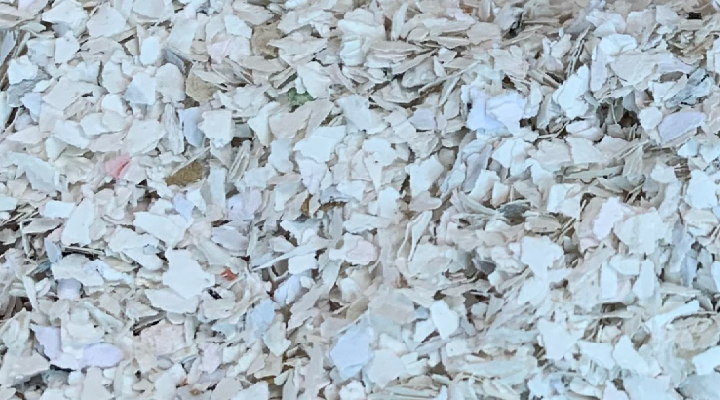The different types of paper shredders
There are many types of paper shredders out there. From home and office shredding machines to industrial shredders, we’ll explain the difference between how these machines work and which you should use to keep your data secure.
Strip-cut shredders
What is strip-cut shredding?
Strip-cut shredding is where a shredder will slice paperwork into long strips. Strip-cut shredders are not typically expensive, and you will usually find the cheaper end of the home shredder market uses the strip-cut method.
Is strip-cut shredding secure?
One of our team was able to reassemble a piece of strip-cut paper in 12 minutes on the first try. Someone with experience in document reassembly would be able to do this much faster. There are even digital technologies that use AI to reconstruct scanned paper strips. For this reason, we would never recommend using a strip-cut shredder. To reassemble strip-cut documents is just a mild inconvenience for a data thief. Because reassembly is so easy, the strip-cut method is not a suitable way to destroy confidential or personal information.
So, why do people use strip-cut shredders?
Strip-cut shredders, while very slow compared with industrial shredders, are typically a little bit faster than a home cross-cut shredder because the machines do less cutting. But is the speed worth the lack of security? As small home and office shredders can usually only shred for a few minutes before needing a long cool-down period, probably not.
Cross-cut shredders
What is a cross-cut shredder?
Cross-cut shredders are sort of like strip-cut shredders, but instead of the blades cutting paperwork in one linear direction, they cut in a V shape. This results in a much smaller shred size than the strip-cut method, thus making reassembly more difficult.
Should I use a cross-cut shredder at home?
If you do use a shredder at home, you should always be using a cross-cut shredder. Anything less could be a risk to your information. Of course, as a shredding service provider, we would always recommend using a shredding service. But there are reasons we’d advise against a home or office cross-cut shredder, and we would give this advice even if you didn’t shred with us.
When you shred at home, your machine will require regular oiling and maintenance. It will also take a long time to shred and an even longer time for the shredder to cool. You’ll also not have an audit trail for the shredding you have done, whereas with a shredding service provider you will receive a Waste Transfer Note and Certificate of Destruction. Most crucial of all though, when you shred at home, all of your shredded documents are together in one pile. While reassembly is more difficult with cross-cut, it’s not impossible. Cross-cut machines still slice paperwork in a linear way. If someone really wanted to, they could reassemble the fragments with relative ease. If, after shredding, you’re leaving your fragments in an unlocked outside bin, you run the risk of data theft.
Multi-cut shredders
What is a multi-cut shredder?
At Shred Station, our industrial shredders destroy materials in a way we describe as multi-cut. This means that when paperwork or other materials go through our shredders, they are torn apart in multiple directions by rows of square rotating cutting heads. The final product is therefore not linear. As you can see in the image below, the shredded fragments are ripped apart and would therefore be next to impossible to reassemble.

Our industrial shredding machines also have screens below the shredder, meaning only when the fragments are small enough to fit through the screen’s holes will they be able to pass through to our baling machine. If the fragments aren’t small enough, they are continually cut until the fragments are the required size.
When we shred, we also mix the paperwork with tonnes of other paperwork. This extra step of security means that fragments from the same original document are separated.
Granulators
What is a granulator?
A granulator is a machine that can destroy materials into very small fragments. While a shredder cuts paper into pieces using two or more shafts of rotating knives and fingers working against each other, a granulator works by repeatedly cutting materials with one shaft working against a drum.
Imagine a washing machine with thick rotating knives going around the drum, sort of like a fan. This is kind of what a granulator looks like. In a granulator, the blades are very sharp and can cut materials into tiny pieces. Similar to how your washing machine’s drum has holes to let water in and out, granulators also have a screen with holes in it. This screen stops fragments from exiting the granulator until they are small enough to get through the screen’s holes. With our granulators, the screen size can be changed. This allows us to ensure that only small enough materials can pass through the granulator. Screen sizes vary, but typically we would use screens with 10mm holes, 6mm holes, or even 2mm holes depending on the requirements of our customers.
Do I need a granulation service for everyday paperwork?
Granulation isn’t usually needed for everyday paperwork. We only ever recommend granulation for materials that are highly sensitive, such as Top Secret government documents. Granulations is also a popular service for places like embassies. For most other confidential materials, a multi-cut shredding service – our standard – is secure enough.
Sign up for our newsletter to receive alerts about new blog articles, data protection advice, and Shred Station news.
